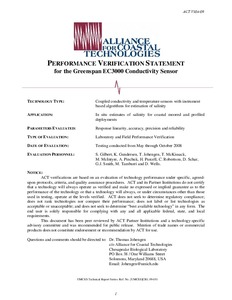| dc.contributor.author | Gilbert, S. | |
| dc.contributor.author | Gundersen, K. | |
| dc.contributor.author | Johengen, T. | |
| dc.contributor.author | McKissack, T. | |
| dc.contributor.author | McIntyre, M. | |
| dc.contributor.author | Pinchuk, A. | |
| dc.contributor.author | Purcell, H. | |
| dc.contributor.author | Robertson, C. | |
| dc.contributor.author | Schar, D. | |
| dc.contributor.author | Smith, G.J. | |
| dc.contributor.author | Tamburri, M. | |
| dc.contributor.author | Wells, D. | |
| dc.date.accessioned | 2019-01-21T12:36:59Z | |
| dc.date.available | 2019-01-21T12:36:59Z | |
| dc.date.issued | 2008 | |
| dc.identifier.citation | Gilbert, S.; Gundersen, K.; Johengen, T.; McKissack, T.; McIntyre, M.; Pinchuk, A.; Purcell, H.; Robertson, C.; Schar, D.; Smith, G.J.; Tamburri, M. and Wells, D. (2008) Performance Verification Statement for the Greenspan EC3000 Conductivity Sensor. Solomons, MD, Alliance for Coastal Technologies, 61pp. (ACTVS04-09). DOI: http://dx.doi.org/10.25607/OBP-324 | en_US |
| dc.identifier.uri | http://hdl.handle.net/11329/767 | |
| dc.identifier.uri | http://dx.doi.org/10.25607/OBP-324 | |
| dc.description.abstract | Instrument performance verification is necessary so that effective existing technologies can be
recognized, and so that promising new technologies can become available to support coastal science,
resource management, and ocean observing systems. The Alliance for Coastal Technologies (ACT) has
therefore completed an evaluation of commercially available in situ salinity sensors. While the sensors
evaluated have many potential applications, the focus of this Performance Verification was on nearshore
moored and profiled deployments and at a performance resolution of between 0.1 – 0.01 salinity units.
In this Verification Statement, we present the performance results of the Greenspan EC3000
conductivity sensor evaluated in the laboratory and under diverse environmental conditions in moored
and profiling field tests. A total of one laboratory site and five different field sites were used for testing,
including tropical coral reef, high turbidity estuary, sub-tropical and sub-arctic coastal ocean, and
freshwater riverine environments. Quality assurance (QA) oversight of the verification was provided by
ACT QA specialists, who conducted technical systems audits and a data quality audit of the test data.
In the lab tests, the Greenspan EC3000 exhibited a strong linear response when exposed to 15
different test conditions covering five salinities ranging from 7 – 34 psu, each at three temperatures
ranging from 6 - 32 oC (R2 = 0.999, SE = 0.118 and slope = 0.997). The mean of the absolute difference
between instrument measured salinity and reference sample salinity for all 15 treatments was -0.0426
±0.1176 psu. When examined independently, the relative accuracy of the conductivity and temperature
sensors were 0.1306 ±0.08902 mS/cm and 0.0935 ±0.1377 oC, respectively.
Across all five field deployments, the range of salinity tested against was 0.14 – 36.97. The
corresponding conductivity and temperatures ranges for the tests were 0.27 – 61.69 mS cm-1 and 10.75 –
31.14 oC, respectively. Extensive and rapid biofouling at the FL and GA test sites severely impacted
instrument performance within approximately one week. Based on initial relative accuracy of the
instrument during the first few days of deployment period, instrument performance was also affected by
calibration issues. The initial offsets in measurement salinity were 0.218, 0.200, and -0.210 for the FL,
GA, and HI test deployments. The accuracy was much better for the entire MI freshwater deployment
and initially for the HI with offsets of -0.0006 and 0.030 psu, respectively. When instrument response
for the first 14 days of deployment was compared together for all five field sites, a fairly consistent and
linear performance response was observed with R2 = 0.982, SE = 1.789 and slope = 0.982.
Performance checks were completed prior to field deployment and again at the end of the
deployment, after instruments were thoroughly cleaned of fouling, to evaluate potential calibration drift
versus biofouling impacts. At the three sites where these tests were successful, field deployment results
were largely reflective of biofouling impacts and not calibration drift in the instrument. On one occasion
a very low negative offset in instrument readings for the pre-test may have resulted from the entrainment
of air bubbles in the conductivity cell.
During this evaluation, significant problems were encountered with the provided software
and several interactions with the manufacturer were required before all instruments could be
programmed properly for the tests. Several of the test sites had incomplete data records. For the
FL field test about 5 % of the data were lost. For the GA field test, a battery failure occurred and
only 7% of the deployment record was useable. For the HI field test, we could not get the
instrument working properly and lost the pre-deployment test and the first week of the mooring
test. Lastly, a check on the instruments time clocks at the beginning and end of field deployments
showed differences of between minus 1 and plus 1 seconds among test sites.
We encourage readers to review the entire document for a comprehensive understanding of
instrument performance. | en_US |
| dc.language.iso | en | en_US |
| dc.publisher | Alliance for Coastal Technologies (ACT) | en_US |
| dc.relation.ispartofseries | ACT VS; 04-09 | |
| dc.rights | CC0 1.0 Universal | * |
| dc.rights.uri | http://creativecommons.org/publicdomain/zero/1.0/ | * |
| dc.title | Performance Verification Statement for the Greenspan EC3000 Conductivity Sensor. | en_US |
| dc.type | Report | en_US |
| dc.description.status | Published | en_US |
| dc.format.pages | 61pp. | en_US |
| dc.description.refereed | Refereed | en_US |
| dc.publisher.place | Solomons, MD | en_US |
| dc.subject.parameterDiscipline | Physical Oceanography | en_US |
| dc.description.currentstatus | Current | en_US |
| dc.description.eov | Sub surface salinity | en_US |
| dc.description.bptype | Best Practice | en_US |
| dc.description.bptype | Standard Operating Procedure | en_US |
| obps.contact.contactemail | info@act-us.info | |
| obps.contact.contactemail | Johengen@umich.edu | |
| obps.resourceurl.publisher | http://www.act-us.info/evaluations.php | en_US |
 Repository of community practices in Ocean Research, Applications and Data/Information Management
Repository of community practices in Ocean Research, Applications and Data/Information Management

